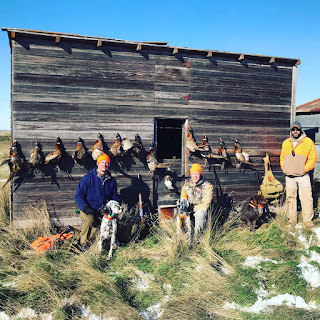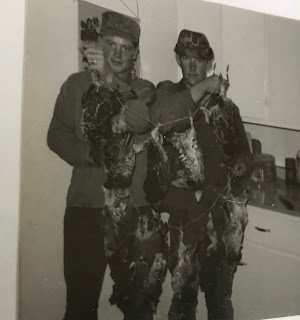 |
| Getting to the point is sometimes the hardest part |
500 miles one-way.
Two mountain passes to cross. Two round trips in two weeks. One with human co-pilot, one with only dog as
co-pilot. Mix in some dreadful night-driving dodging deer and elk. Borderline
crazy. Chukar crazy.
My L-town in central Montana is regarded and regurgitated by
outdoor media as an upland bird hunting mecca. With sage grouse, sharptail,
Huns, pheasants, blue grouse and ruffs all within an hour of town, there is a
lot to like. However, the amount of access may not justify the hunting pressure
or the notoriety. To prove my point, I have only hunted two half-days locally,
spread out amongst 25+ days afield. And
the biggest drawback to Fergus County, Montana? There aren’t any chukars.
I first shot wild chukars south of Billings, MT in marginal
habitat about 15 years and three setters ago, on my third attempt. I opened my over-under after four birds
bagged as I didn’t even know the limit.
I assumed it was the same as Hungarians (eight), but wasn’t 100%
sure. No regrets as I look back, knowing
that a four-bird day is respectable anywhere.
I mounted one of those first chukars, the catalyst for my current
addiction.
 |
| This bird was close to dropping off the edge of the world |
Fast-forward to 2019 and the challenge and pure sport of chasing
these imported birds have not waned. So much of one’s success is determined by
1) your ambition level 2) quality of the dog work. 99.9% of the hunting occurs on public land so
the barriers to access have been removed.
For those hunters that are looking for adventure, great exercise,
tremendous scenery, majestic dog work and tricky shotgunning, chukar hunting
offers all of it.
Imagine your heart-pounding as you shift down into uphill
gear, alternating your view from the ground to the dog to the ground and back
to the dog. She looks birdy, hunting
deliberately toward a rock outcropping near the top of the ridge. You question
if you can pause a second to catch your breath, but you think better of it,
wanting to stay with the dog as she approaches the crest. She does her part, locking up on strong
scent, giving you time to try and find solid footing. Just as your eyesight clears the horizon, the
covey rise explodes, giving you milliseconds to pick out a single target, two
if you are fortunate. In good chukar
country, this excitement is repeated throughout the day. Over the course of
several hours, you will have taken a number of shots that didn’t connect, a few
that do. You will have fallen a few
times, hopefully with only minor damage to both your gun and you. Your evening is spent reliving the dog’s
greatest hits, eating as many calories as you care to enjoy, hoping you can
muster the energy to climb the hills again tomorrow. Somehow you always find that reserve tank to
return. Even when those hills are 500 miles from home.
 |
| Backpacking into birds. Where do you put your vest? |













